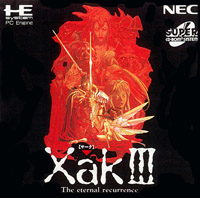Setting and story
Xak features a typical high fantasy setting. According to the game world's legends, a great war was fought between the benevolent but weakening ancient gods and a demon race, which led to the collapse and eventual mortality of the gods. After this 'War of Sealing', the gods divided the world into three parts: Xak, the world of humans, Oceanity, the world of faeries, and Xexis, the world of demons. The demon world of Xexis was tightly sealed from the other two worlds as to prevent reentry of the warmongering demon race. Some demons were left behind in Xak, however, and others managed to discover a separate means to enter Xak from Xexis anyway.
At this point in the series the main hero, Latok Kart, has become a powerful adversary against the demons and their plots to conquer the world of Xak as he has triumphed over many powerful demons, including Zemu Badu, Zamu Gospel, Zegraya and Gazzel. Latok is a direct descendant of an ancient god of war, Duel, and his deeds have since become well known throughout the world of Xak as the legendary "Duel Knight", armed with a powerful relic known as the "Xak Sword". During this time a short-lived peace has been disrupted by the sudden attack of the nearby Kingdom of Farland led by a demon named Zomu Dizae. Latok learns of this and sets out for the Kingdom of Farland.
Gameplay
Xak III is a classic dungeon crawl, in that the game proceeds by the player finding his way through labyrinthine maps, defeating opposing monsters on the way. In each map, keys, NPCs and other objects have to be found to gain entrance to the room where a boss dwells. After defeating the boss, the player can proceed towards the next map, where the structure repeats. Various sub-quests involving NPCs are present, most of them obligatory.
Combat is in real-time. The player's character walks around on the game maps, as well as the monster characters. Each character has an attack and defense rating, different for each of its four sides. Moreover, Latok's ratings change depending on whether he is attacking or defending. As Latok or a monster takes damage or wards off an attack, the character is pushed backwards. This combat system requires some manual dexterity, especially during boss fights—bosses are generally several times larger than Latok himself.
Latok advances in power through a classic leveling system. He starts from experience level 50, where Xak II (and The Tower of Gazzel) ended. Moreover, there are several shops scattered through the game where Latok can buy stronger swords, armours and shields. Gold, the game's currency, and experience points are awarded for killing monsters that wander the map.

The black knight is a literary stock character who masks his identity and that of his liege by not displaying heraldry. Black knights are usually portrayed as villainous figures who use this anonymity for misdeeds. They are often contrasted with the knight-errant. The character appeared in Arthurian literature and has been adapted and adopted by various authors, in cinema and popular culture. The character is sometimes associated with death or darkness.

Final Fantasy IV, a role-playing video game released by Square in 1991, revolves around Cecil Harvey, a knight of Baron who embarks on a quest to defeat Golbez, a man that is controlling the king of Baron. During Cecil's quest, he is joined by his childhood friends Kain Highwind and Rosa Farrell, as well as other warriors from around the world who also seek to stop Golbez. The visuals of the characters were designed by Yoshitaka Amano. After its initial release, Final Fantasy IV was later ported to multiple consoles. In 2007, Square Enix released an enhanced remake for the Nintendo DS that added voice acting to both the Japanese and English versions.

Wonder Boy in Monster World, known in Japan as Wonder Boy V: Monster World III, is a side-scrolling action role-playing game originally developed by Westone and published by Sega for the Mega Drive/Genesis in 1991. It is the fifth game in the Wonder Boy series and the third game in the Monster World sub-series, following Wonder Boy in Monster Land and Wonder Boy III: The Dragon's Trap.

Tecmo Knight, known in Japan as Wild Fang (ワイルドファング), is a 1989 beat 'em up arcade game developed and released by Tecmo.
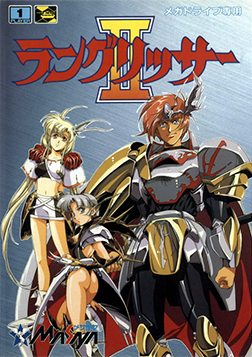
Langrisser II is a tactical role-playing game for the Sega Mega Drive console. It is the sequel to Langrisser, and was never released outside Japan. Langrisser II was remade for the Super Famicom by Masaya as Der Langrisser, which featured multiple paths through the game, greatly reduced difficulty, and reworked graphics. A PC-FX port, Der Langrisser FX, was also released, featuring animated cutscenes. It was later compiled with the first Langrisser for the PlayStation as Langrisser I & II , and then given a script edit and new branch of the Imperial path in its Saturn remake as Langrisser: Dramatic Edition. A Windows 98 port of the game was released in Japanese, Chinese and Korean; it features redrawn, high-resolution graphics, but a vastly trimmed-down soundtrack to fit the confines of a standard CD. A full remake of Langrisser I & II was also released in 2019 on both Sony PlayStation 4 and Nintendo Switch and on PC in 2020, featuring new graphics and BGM.
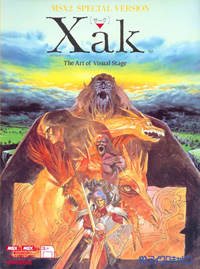
Xak: The Art of Visual Stage (サーク) is a 1989 role-playing video game by Microcabin. The first game in the Xak series, it was originally released for the PC-88 computer system, with subsequent versions being developed for the PC-98, X68000, MSX2, PC Engine, Super Famicom, and mobile phones. The first four versions were re-released for Windows on the online store Project EGG. An English translation of Xak: The Art of Visual Stage was also released in 2007 on the now-defunct retro gaming service WOOMB.net, and became available on Project EGG.

Xak II: Rising of the Redmoon is a 1990 role-playing video game by Microcabin. It is a direct sequel to Xak: The Art of Visual Stage. The game was released in Japan only, but due to a MSX scene that arose in Europe some of the MSX versions of Xak received fan translations. An enhanced remake was later released for the PC Engine, together with the first game in the series Xak as Xak I & II by Telenet Japan's development team Riot.
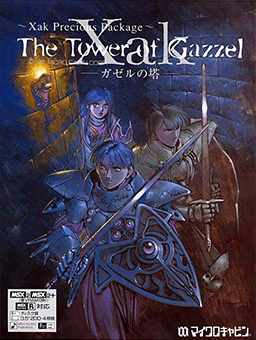
Xak Precious Package: The Tower of Gazzel is a fantasy role-playing video game developed and published by the Japanese software developer Microcabin. The game is a direct sequel to Xak: The Art of Visual Stage and Xak II: The Rising of the Red Moon. While technically being the third installment of the series, The Tower of Gazzel is a sidestory taking place between the events of Xak II and Xak III. The game was released in Japan only.
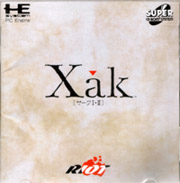
Xak I & II is a re-release of Xak (1989) and Xak II (1990), a fantasy role-playing video game series Xak developed and published by the Japanese software developer Microcabin and Telenet Japan's development team Riot. This set contains both the first two Xak series games back-to-back on one complete Super CD-Rom^2 with enhanced graphics and sound. In a similar style to Ys I & II, also for the PC Engine system, Xak II, the second game in the series picks up immediately as the first game concludes. Xak I & II was a Japanese release only and although the first two Xak games have been translated into English on the MSX2, the PC Engine versions remain untranslated for now.

Fray in Magical Adventure, also known as just Fray (フレイ) and Fray-Xak Epilogue (Gaiden), is a 1990 spin-off "gaiden" (sidestory) game in a role-playing video game series Xak developed and published by the Japanese software developer Microcabin. Even though it is directly connected to the more serious Xak storyline, Fray has a less serious tone and light-hearted comedic approach to telling the story. It was originally released for the MSX2 and was later ported to several different systems, among them MSX Turbo R, PC-98, PC Engine, and Game Gear.
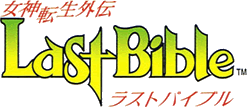
Megami Tensei Gaiden: Last Bible is a role-playing video game series developed by Multimedia Intelligence Transfer, Sega, and Menue, and published by Atlus and Sega for multiple platforms. The first game of the series, Revelations: The Demon Slayer, was released in 1992; this is the only title in the series to have been released in English. After The Demon Slayer, two sequels and five spin-off titles have been released. In the main series titles, players explore the game world and fight monsters in menu-based battles; players can also attempt to recruit monsters to their party, and can fuse two allied monsters into a single new one to try to get stronger monsters. The spin-off title Another Bible is a turn-based strategy game, while Last Bible Special is a role-playing game controlled from a first-person perspective.
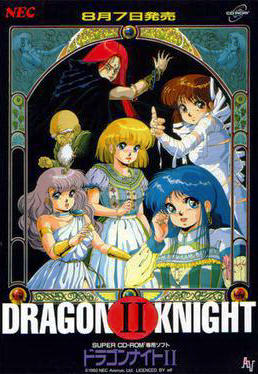
Dragon Knight II (ドラゴンナイトII) is a fantasy-themed eroge role-playing video game in the Dragon Knight franchise that was originally developed and published by ELF Corporation in 1990-1991 only in Japan as the first sequel to the original Dragon Knight game from 1989. The game is an erotic dungeon crawler in which a young warrior Takeru fights to lift a witch's curse that has turned girls into monsters.
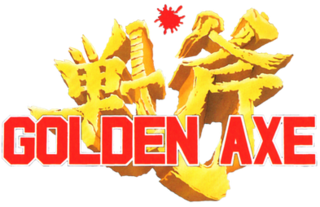
Golden Axe is a series of side-scrolling beat 'em up arcade video games developed by Sega. The series takes place in a medieval fantasy world where several heroes have the task of recovering the legendary Golden Axe, the mainstay element of the series.
Chimera, originally found in Greek mythology, is a monstrous fire-breathing creature composed of the parts of multiple animals. The term, and often the general concept, has since been adopted by various works of popular culture, and chimeras of differing description can be found in contemporary works of fantasy and science fiction.
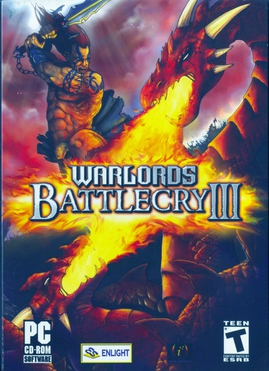
Warlords Battlecry III is a real-time strategy game developed by Infinite Interactive and published in 2004. It is the third installment in the Warlords Battlecry series and the sequel to Warlords Battlecry II.

Diablo is an action role-playing dungeon crawler video game series developed by Blizzard North and continued by Blizzard Entertainment after the North studio shut down in 2005. The series is made up of four core games: Diablo, Diablo II, Diablo III, and Diablo IV. Expansions include the third-party published Hellfire, which follows the first game; Lord of Destruction, published by Blizzard and released after the second game; Reaper of Souls, which follows the third game; and the upcoming Vessel of Hatred, which will follow the fourth game. Additional content is provided through story elements explored in other types of media forms.

Illidan Stormrage is a fictional character who appears in the Warcraft series of video games by Blizzard Entertainment.
